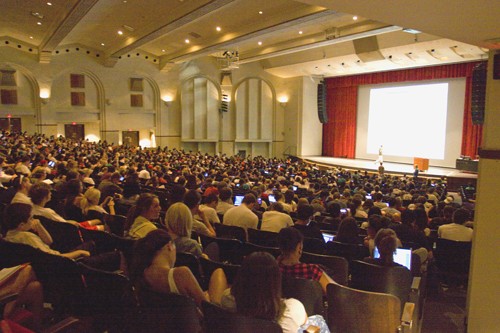The College of Science at the University of Arizona is hosting a free lecture series from February to March for the general public. Lecturers involved in various science topics will help spread awareness about popular misconceptions and how we can work toward solutions.
Every lecture begins at 7 p.m. in Centennial Hall. Music from Arizona Arts Live and poetry from students in the University of Arizona Poetry Center will accompany each science lecture. The College of Science will also live stream the talks on their UAZScience Youtube channel for later viewing.
The first lecture was held on Feb. 1 and was titled: “Precision Aging: Busting the one-size-fits-all myth.” Lee Ryan, professor and head of the Department of Psychology, discussed myths concerning how the brain changes through aging and the consequent cognitive changes.
“People assume that everybody ages in exactly the same way and that our periods of aging are exactly the same,” Ryan said. “And that’s really not true. It’s way more complicated. And it’s actually much more positive than most people in our society really think.”
According to Ryan, society focuses so much on the negative aspects of aging, such as making it synonymous with decline and loss when it isn’t all about that. There is enormous variability, as sometimes older people perform better in their cognitive functions than younger individuals.
There is also an ongoing research study at UA that involves studying individual differences as we age to understand precision aging, including a new $60 million grant from the National Institute on Aging. According to Ryan, concentrating on individuals and their unique risks and resilience factors will lead to finding the best help for each person’s brain health.
The second lecture, scheduled for Feb. 8, is titled: “Are computers as smart as you think?” Eduardo Blanco, associate professor in the Department of Computer Science, will teach the lecture.
The lecture will address what modern computers can and cannot solve and what computers can reliably accomplish. According to Blanco, it will discuss how computers can solve some problems easily, but with other problems that involve intuition or life experience, they can make mistakes.
“But computers are deployed to solve sets of problems, knowing that they are not always going to get it right,” Blanco said. “It’s just something we need to be aware of. Just because a computer says something, that doesn’t necessarily mean that we are to trust every single time they output something.”
“At the end of the day, [computers] are doing whatever the human tells them to do,” Blanco said.
Sometimes simple problems that seem straightforward to a human can cause a computer to struggle. According to Blanco, we should question computers the same way we would question social media or knowledge in general.
The third lecture, scheduled for Feb. 15, is titled: “Climate is always changing. So why is climate change a problem?” Jessica Tierney, professor of geosciences, will clarify this subject.
The lecture will discuss why climate change is now a problem, even though our climate has been warmer in the geological past and carbon dioxide levels have also been higher.
According to Tierney, this problem is in part because of how we have changed our climate in comparison with other instances on the geological record.
“Humans have actually changed climate really fast, so much faster than these geologically ancient warm climates occurred,” Tierney said. “The fact is, humans and ecosystems really struggle to adapt to fast climate changes.”
It is less likely now that humans will face extreme amounts of warming and carbon dioxide by the end of the century because of efforts made by countries and individuals. According to Tierney, it can be better still — less warm is better.
The last lecture is scheduled for March 1 and is titled: “Origins of the Covid-19 Pandemic: Facts and Fallacies.” This lecture is led by Michael Worobey, professor and head of the Department of Ecology and Evolutionary Biology at the UA.
According to Worobey, a lot of discussions out there about where COVID-19 originated and how it emerged are not correct, and this lecture will be an opportunity to shine a light on what the evidence says.
According to the evidence, COVID-19 began through wildlife sales at a particular market in Wuhan, China, Worobey said.
According to Worobey, when the original Severe Acute Respiratory Syndrome emerged, it jumped multiple times from varying animals, and these animals served as intermediate hosts to provide a bridge between where SARS-like viruses usually exist, such as in bats or humans.
Because of this, Worobey pointed out the likelihood is that this was the route that the coronavirus SARS-CoV-2 took to get from bats and ultimately into humans to cause COVID-19.
According to Worobey, it was a rare event that this virus could infect a different animal, and then it was a rare event that it subsequently infected a human.
“It’s the worst pandemic that we’ve had since the Spanish flu more than 100 years ago, but it’s really clear that we’re likely to have another event like this sooner rather than later,” Worobey said. “And, we need to understand how [COVID-19] happened if we’re going to have the best chance to actually prevent the next one.”
In science, the border between myths and facts can be difficult to figure out if we lack the knowledge or answers. As a result, this UA lecture series will help break down some of our preconceived notions about science.
Follow the Daily Wildcat on Twitter









